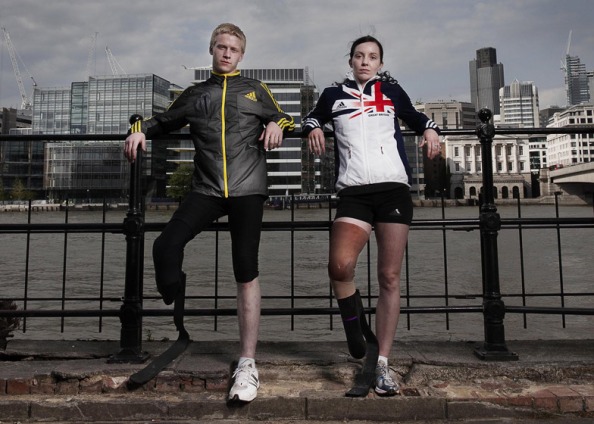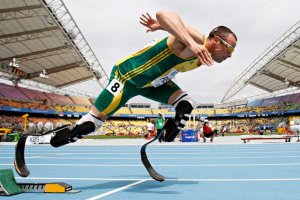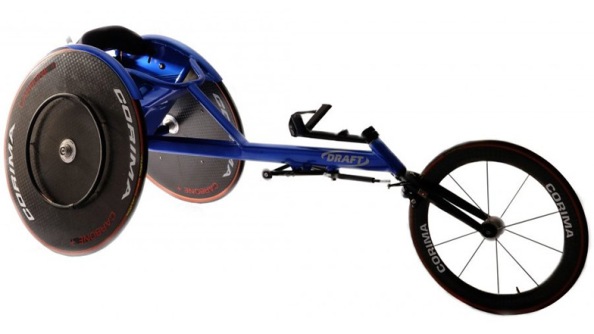Whatever your opinion of elite athletes using technology to gain an advantage you have to feel for Oscar Pistorius and Paralympians in general. Pistorius made history by becoming the first athlete to compete in both Olympic and Paralympic games. Yet this fact taken alongside the evolution of sporting prosthetics and other technologies has created a situation where it seems no-one really knows what is legitimate.
Bryce Dyer is a senior lecturer in product design at Bournemouth University and a specialist in sporting technologies. ‘Prosthesis, Disability and the role of Technology in Elite Sport’ was the title of his award-winning lecture at the British Science Festival and he painted a revealing picture of the struggle to gain sporting advantage in elite athletics.
Blade runner
Pistorius was the subject of controversy long before his ongoing murder case in South Africa. Athletics governing body, the IAAF, banned him from competing in the 2008 Beijing Olympics saying that his blades gave him an unfair advantage over other runners. As a bilateral trans femoral amputee (double amputation above the knee), Pistorius wears two vacuum-sealed carbon fibre leg blades (known as Cheetah Flex feet) that the IAAF called an active advantage, rather than a necessity.
In the end the ban was lifted. Pistorius did not qualify for the South African Olympic team in 2008, instead he went on to win three golds in the Paralympics 400m, 200m and 100m events. But his triumph against the IAAF’s ruling was based on the premise that he would not change the running technology he was using, a measure that has potentially been broken by the South African, Dyer believes, as his running style has changed so much. From starting badly but gaining an advantage in the final metres of a race, to starting well and not having a finishing advantage, Dyer infers that this may have been achieved by adjusting the blade.
Controversy decades old
None of this controversy is new in sport. Many advances have been banned over the past 40 years – full body swimsuits, the Polara golf ball, spaghetti strung tennis racquets – even new techniques such as Graeme Obree’s method of riding his bike. The ‘Flying Scotsman’ received two bans at the World Cycling Championships for his chest forward and ‘Superman’ cycling positions. Each of these has been deemed unfair on competitors.
Even in today’s Paralympic competition you only have to go back a few years to see that not all athletes are created equal. Any small gains that can be won by innovative rather than illegal design will be used by a successful team. Look at the quality of prosthetic limbs and it can vary on the funding and quality of science available to a Paralympian. David Weir, the incredibly successful wheelchair racer, harnesses his considerable athletic ability to the best wheelchair body that science can develop and money can buy.
Arms race
Dyer quotes Dave Brailsford, head of the Cycling GB Olympics and Tour de France Sky teams, whose method was to use the “aggregation of cumulative gains”. Winners are created by getting lots of small advantages – one-hundredth of a second here and there. What we have is an arms race.
It is impossible, even given the modern classifications available to officials, to create equal races in many Paralympic disciplines, said Dyer. In his words, the difference between trans femoral and trans tibial runners, single and double amputees, creates such a difference in running style that it is like comparing apples and oranges. Take all of the Paralympic events together and add in the complex ways that disabilities affect the way the body moves, then throw in ‘enabling’ technologies and you create a situation where nobody really knows for sure what should be allowed.
Bionics
Power-assisted limbs or body parts are next on the philosophical chopping block, said Dyer. No carbon fibre blade will ever be as efficient as an ankle or foot, he said, so what about allowing disabled athletes to wear newly developed power-assisted feet? How do we decide what is an unfair advantage? Surely to allow a disabled athlete to compete with able-bodied sportsmen we should allow them to level the playing field as much as possible.
More apt to this discussion, in Olympic and Paralympic sports where does the amateur athlete end and the professional begin – with the type of leg they can afford or the advances their scientific teams can make? Dyer posed many probing and diverse ethical questions during his session and admitted that as an athlete himself he would try to gain an advantage over an opponent at every turn. Perhaps pushing the boundaries of what is allowed is the unwritten rule in athletic achievement.
BSF factoid:
Cosmesis is where a body part is replaced by a prosthetic that replicates the lost part. One of the oldest examples of this is a 3,000-year-old prosthetic foot from ancient Egypt.



wlvdigital
October 20, 2013
Hi, don’t know how I missed this. Many thanks for the link.